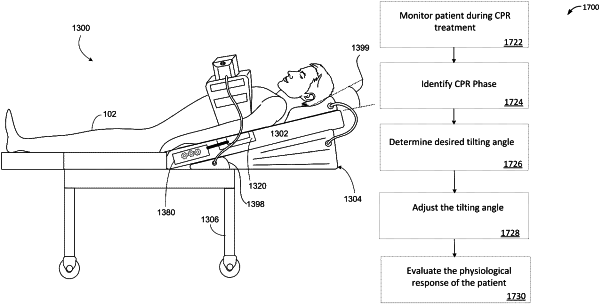| CPC A61H 31/005 (2013.01) [A61G 1/04 (2013.01); A61G 1/044 (2013.01); A61G 7/015 (2013.01); A61G 7/018 (2013.01); A61G 7/07 (2013.01); A61G 7/072 (2013.01); A61G 7/16 (2013.01); A61H 31/006 (2013.01); A61H 31/007 (2013.01); A61H 31/008 (2013.01); A61G 2203/30 (2013.01); A61G 2203/42 (2013.01); A61H 2031/001 (2013.01); A61H 2031/002 (2013.01); A61H 2201/0103 (2013.01); A61H 2201/107 (2013.01); A61H 2201/1246 (2013.01); A61H 2201/501 (2013.01); A61H 2201/5069 (2013.01); A61H 2201/5084 (2013.01); A61H 2230/045 (2013.01); A61H 2230/208 (2013.01); A61H 2230/255 (2013.01)] | 33 Claims |

|
1. A system for assisting cardiopulmonary resuscitation (CPR) treatment of a patient, the system comprising:
a defibrillator system comprising a defibrillator communicatively coupled to a local computing device and configured to receive signals from one or more treatment sensors;
at least one physiological sensor configured to detect physiological signals of the patient;
at least one patient support section, and
at least one tilt adjuster coupled to the at least one patient support section,
wherein the local computing device is configured to:
generate a first control signal indicative of a first target tilt angle prior to performing chest compressions for the patient,
during performance of the chest compressions for the patient, receive and process the physiological signals from the at least one physiological sensor,
analyze the received and processed physiological signals to determine a trend of at least one physiological parameter of the patient, and
generate a second control signal indicative of a second target tilt angle based, at least in part, on the determined trend, and
wherein the at least one tilt adjuster is configured to:
communicatively couple with the defibrillator system,
receive the first control signal indicative of the first target tilt angle from the local computing device,
automatically tilt the at least one patient support section, around a transverse axis, to the first target tilt angle in response to the first control signal from the local computing device,
during performance of the chest compressions for the patient, receive the second control signal indicative of the second target tilt angle from the local computing device, and
automatically tilt the at least one patient support section, around the transverse axis, to the second target tilt angle, which is different than the first tilt angle; and
a chest compression (CC) device mount disposed on the at least one patient support section and configured to adjustably secure a CC device to the at least one patient support section.
|